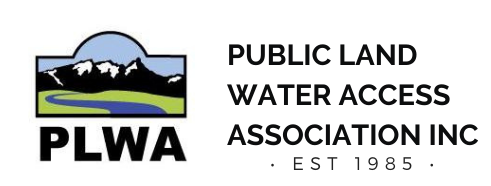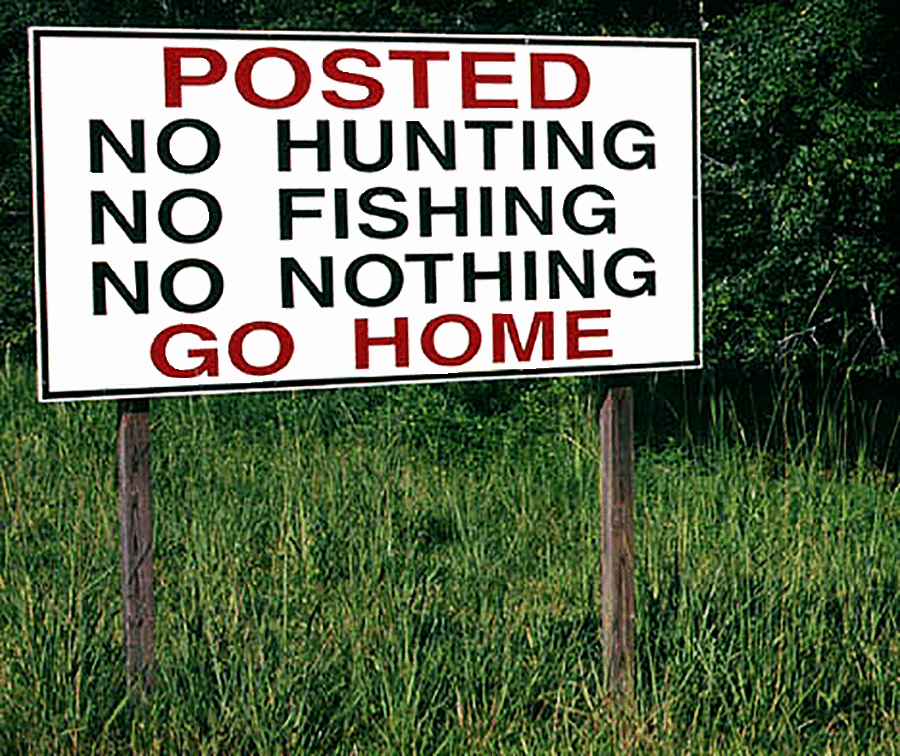
State Laws Related to Public Roads
In the state of Montana, laws regarding public access on public roadways vary depending on the land ownership of the parcel where a road is located. For example, a public road may be located within the bounds of the National Forest, Bureau of Land Management (BLM), Tribal Nations, various types of State Lands, or constitute an easement which travels through private land. In many cases, a particular road may pass through several or all of these types of land holdings, requiring cooperation between multiple entities.
Depending on the situation, the overseeing authority may have the ability to temporarily close or restrict access to a road for several reasons. For example, within the National Forest, administrators may close access or limit access for the purpose of wildfire fighting or safety concerns during a mudslide or road maintenance. Similarly, a County may need to restrict or close access to a portion of a county road that has become unsafe until they are able to allocate funds and services to repair it. This does not mean that a public County Road can be permanently closed without due process if it leads to a public land or water, or serves multiple (more than 2) households beyond. However, there is some discretion about the triaging and timeline with which this process may occur. Residents and organizations concerned about access and resource management within the County are encouraged to address these elements at County Commission meetings to ensure that access is a priority. PLWA focuses on public access issues up to the boundaries of our public lands and waters, and generally leaves oversight of the management of public lands and waters within to our partner organizations and supervising entities.
Private parties frequently illegally close public roads and backroads leading to public land. Action to open them can require legal action involving esoteric and arcane case law such as public prescriptive easements, or the old RS2477 federal statute. However, some closed roads are clearly established county roads. The responsibility of counties regarding county roads has been outlined by the Montana legislature. County roads are roads created by a County Commission action and usually, but not always, maintained by the county.
The county public works department or road department is required to have a record of all county roads. Someone with questions about a specific road should start with the county public works director or road supervisor to check if the road is officially recognized. However, just because they say it isn’t a county road, don’t take that as the final answer.
If you find that a road is in fact a county road and it has been closed, blocked, barricaded, or encroached upon, there are a variety of laws which you can bring to the attention of county commissioners. All legal references are to the Montana Code Annotated, which is available online.
ABANDONMENT OF A COUNTY ROAD: A county road cannot be abandoned arbitrarily by the county.
7-14-2615. Abandonment or vacation of county roads. (1) All county roads once established must continue to be county roads until abandoned or vacated by:
(a) operation of law;
(b) judgment of a court of competent jurisdiction; or
(c) the order of the board.
(2) An order to abandon a county road is not valid unless preceded by notice and public hearing.
(3) The board may not abandon a county road or right-of-way used to provide existing legal access to public land or waters, including access for public recreational use as defined in 23-2-301 and as permitted in 23-2-302, unless another public road or right-of-way provides substantially the same access.
(4) The board may not abandon a county road or right-of-way used to access private land if the access benefits two or more landowners unless all of the landowners agree to the abandonment.
ENCROACHMENT ON A COUNTY ROAD: No party can “encroach” upon or block a county road. While encroachment is not defined in the statute, clearly a fence or other obstruction in the roadway preventing travel would seem to be an encroachment.
7-14-2134. Removal of highway encroachment.
(1) Except as clarified in 23-2-312 and 23-2-313 and except as provided in subsection (4) of this section, if any highway is encroached upon by fence, building, or otherwise, the road supervisor or county surveyor of the district must give notice, orally or in writing, requiring the encroachment to be removed from the highway.
(2) If the encroachment obstructs and prevents the use of the highway for vehicles, the road supervisor or county surveyor shall immediately remove the encroachment.
(3) The board of county commissioners may at any time order the road supervisor or county surveyor to immediately remove any encroachment.
(4) This section does not apply to a fence for livestock control or property management that is in a county road right-of-way and that is attached to or abuts a county road bridge edge, guardrail, or abutment if the fence and bridge appurtenances are not on the roadway, as defined in 61-1-101. Any fence described in this subsection must comply with 23-2-313.
7-14-2135. Notice to remove encroachment.
(1) Notice to remove the encroachment immediately, specifying the breadth of the highway and the place and extent of the encroachment, must be given to the occupant or owner of the land or the person owning or causing the encroachment.
(2) Notice must be given in the following manner:
(a) by leaving it at the occupant’s or owner’s place of residence if the person resides in the county; or
(b) by posting it on the encroachment if the person does not reside in the county.
7-14-2136. Penalty for failure to remove encroachment promptly. If the encroachment is not removed immediately or removal is not diligently conducted, the one who causes, owns, or controls the encroachment is liable to a penalty of $100 for each day the same continues.
7-14-2137. Legal actions to remove encroachments or recover costs.
(1) (a) If the encroachment is denied, the road supervisor shall commence an action in the proper court to abate the encroachment as a nuisance.
(b) If the road supervisor recovers judgment, the supervisor may have the supervisor’s costs and $10 for each day the nuisance remains after notice.
(2) (a) If the encroachment is not denied and is not removed for 5 days after notice is complete, the road supervisor or county surveyor may remove it at the expense of the owner or occupant of the land or of the person owning or controlling the encroachment.
(b) The supervisor may recover the expense of removal, $10 for each day the encroachment remains after notice, and costs in an action brought for that purpose.
OBSTRUCTIONS ON COUNTY ROADS, no one can “obstruct” a county road as per 7-14-2133.
7-14-2133. Removal of obstructions on county roads.
(1) When a county road becomes obstructed, the board of county commissioners, or the county surveyor if the surveyor is in charge, shall remove the obstruction upon being notified of the obstruction.
(2) This section does not hold the board or any member responsible or liable for anything other than willful, intentional neglect or failure to act.
(3) For the purposes of this section, “obstruction” means an obstacle, such as a rock or a fallen tree, that if not removed would remain in the road indefinitely. The word does not mean snow, ice, or any other obstacle that will melt or dissipate on its own accord.
Additional Laws That May Be Helpful:
7-14-2112. Width of roads.
(1) The width of all county roads, except bridges, alleys, or lanes, must be 60 feet unless a greater or smaller width is ordered by the board of county commissioners on petition of an interested person.
(2) The width of all private highways and byroads, except bridges, must be at least 20 feet.
(3) Nothing in this section shall be construed as increasing or decreasing the width of either kind of highway or road established or used as such prior to December 31, 1966.
61-1-101. Definitions. As used in this title, unless the context indicates otherwise, the following definitions apply:
(28) "Highway" or "public highway" means the entire width between the boundary lines of every publicly maintained way when any part of the publicly maintained way is open to the use of the public for purposes of vehicular travel.
61-8-210. Display of unauthorized signs, signals, or markings.
(1) A person may not place, maintain, or display upon or in view of a highway any unauthorized sign, signal, marking, or device that purports to be or is an imitation of or resembles an official traffic control device, that attempts to direct the movement of traffic, or that hides from view or interferes with the effectiveness of any official traffic control device or flag person.
(2) A person may not place or maintain and a public authority may not permit commercial advertising on an official traffic control device on a highway, except for business signs included as a part of official motorist service panels or roadside area information panels approved by the department of transportation.
(3) This section does not prohibit the erection of signs upon private property adjacent to highways that give useful directional information and that are of a type that cannot be mistaken for official signs.
45-8-115. Illegal posting of state and federal land.
(1) A person commits the offense of illegal posting of state or federal land if, without authorization, the person knowingly posts land that is under the ownership or control of the state or federal government to restrict access or use of state or federal land.
(2) A person convicted of illegal posting of state or federal land shall be fined an amount not to exceed $500 or be imprisoned in the county jail for a term not to exceed 6 months, or both.

